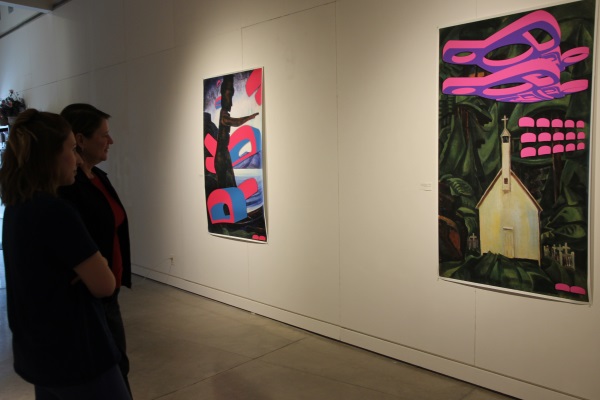Examining the 'multiplicity of history'
March 10, 2016
Share
Layers of history are on display at the Union Gallery – in a show featuring digital paintings that examine and question the ways Canada has been portrayed over time, largely through a settler-colonial lens.
In the artworks, celebrated Vancouver-based artist Sonny Assu overlays Indigenous iconography on paintings by artists such as Emily Carr, Edwin Holgate and Paul Kane, effectively conveying multiple histories at once.

“The works speak back to these canonized images of Canadian history,” says Ellyn Walker, a PhD student in the Cultural Studies Program who curated the show as part of her research. “These famous paintings, while intentional or not, didn’t properly or accurately acknowledge Indigenous presence on the land, such as in many of the sites that they portray, and Assu’s works challenge that.”
In all the works at the gallery, Assu placed formlines – shapes and images that are specific to the Pacific Northwest and found on Indigenous arts such as textiles and totem poles – in bold, neon colours on the paintings, in an effort to “speak back to their missing histories,” explains Walker.
Assu, who is Ligwilda’xa (We Wai Kai) of the Kwakwaka’wakw nations, graduated from Emily Carr University and has won numerous awards. His work has been accepted into the collections of the National Gallery of Canada, the Seattle Art Museum, the Vancouver Art Gallery, and in various other private and public collections across Canada, the U.S., and the U.K.
“I hope the show helps people become more interested in art history, and the multiplicity of history,” says Walker. “The exhibition asks us to look critically – and look again – at artwork made in Canada, meant to represent Canada, and how the places in which we live are in fact colonial sites.”
The exhibition, which runs until March 19, also includes a curators’ discussion at the gallery on the final day of the show. Walker, along with Carina Magazzeni, will discuss “curating as research” and the possibilities and limitations associated with this pedagogical method. She also hopes to discuss her theories on “curating as relationships,” and curating as a tool for negotiation.
Jocelyn Purdie, Director of the Union Gallery, says Walker’s show of Assu’s work is one of the ways the gallery provides experiential learning opportunities for students. Walker, as part of her work in cultural studies, is on a placement and mentorship with the gallery as their programming and research assistant.
More information on the Re-mixed: Reconfiguring the Imaginary exhibition is available at the Union Gallery website, on Facebook, and by email.